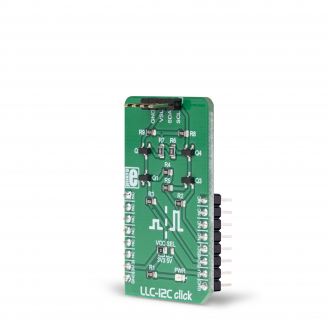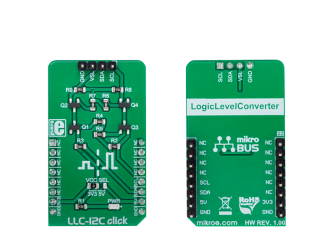
We strongly encourage users to use Package manager for sharing their code on Libstock website, because it boosts your efficiency and leaves the end user with no room for error. [more info]

Rating:
Author: MIKROE
Last Updated: 2018-12-18
Package Version: 1.0.0.0
mikroSDK Library: 1.0.0.0
Category: Port expander
Downloaded: 4846 times
Not followed.
License: MIT license
LLC I2C click can be utilized as the level converter for the logic signals, which makes it a very useful Click board. The topology of this logic level conversion (LLC) circuit is perfectly suited for the bi-directional I2C communication.
Do you want to subscribe in order to receive notifications regarding "LLC I2C click" changes.
Do you want to unsubscribe in order to stop receiving notifications regarding "LLC I2C click" changes.
Do you want to report abuse regarding "LLC I2C click".


Library Description
The library contains functions for starting, writing data to I2C wires and reading data from I2C wires.
Key functions:
void i2cllc_start() - The function executes start condition on I2C wires.void i2cllc_write(uint8_t slaveAddress, uint8_t *pBuf, uint16_t nBytes, uint8_t endMode) - The function should execute write sequence on I2C wires.void i2cllc_read(uint8_t slaveAddress, uint8_t *pBuf, uint16_t nBytes, uint8_t endMode) - The function should execute read sequence on I2C wires.Examples description
The application is composed of the three sections :
Note: The start configuration chip is required at the beginning of each program so that the chip wakes up and prepares for operation and measurement. What is included and set in the start-up function can be viewed in the help file.
void applicationTask()
{
// Thermo 7 measurement Temperature
uint8_t writeReg[ 1 ];
uint8_t readReg[ 2 ] = {0};
float Temp_msb;
uint8_t Temp_lsb;
char tempText[ 50 ];
writeReg[ 0 ] = 0x00;
i2cllc_start();
i2cllc_write( 0x48, &writeReg[0], 1, _I2CLLC_END_MODE_RESTART );
i2cllc_read( 0x48, &readReg[0], 2, _I2CLLC_END_MODE_STOP );
Temp_msb = readReg[ 0 ];
Temp_lsb = readReg[ 1 ] & 0xF0;
if( temp_lsb & 0x80 ) Temp_msb += 0.50;
if( temp_lsb & 0x40 ) Temp_msb += 0.25;
if( temp_lsb & 0x20 ) Temp_msb += 0.125;
if( temp_lsb & 0x10 ) Temp_msb += 0.0625;
FloatToStr(Temp_msb, tempText);
mikrobus_logWrite(" Ambient temperature : ", _LOG_TEXT );
mikrobus_logWrite(tempText, _LOG_TEXT);
mikrobus_logWrite(" C", _LOG_LINE);
Delay_ms( 1000 );
}
Other mikroE Libraries used in the example:
I2C
Additional notes and information
Depending on the development board you are using, you may need USB UART click, USB UART 2 click or RS232 click to connect to your PC, for development systems with no UART to USB interface available on the board. The terminal available in all MikroElektronika compilers, or any other terminal application of your choice, can be used to read the message.